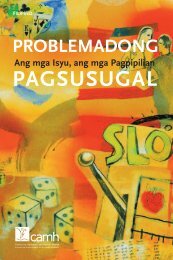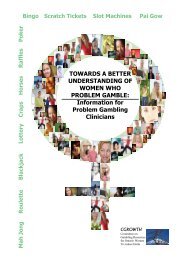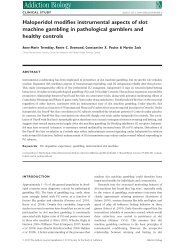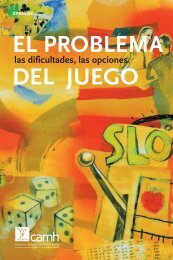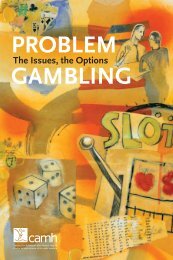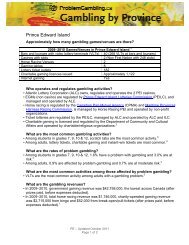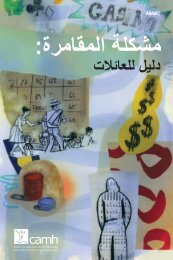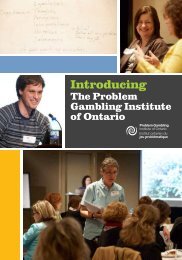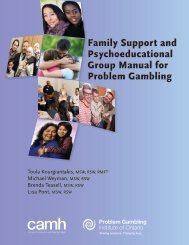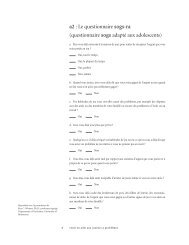CAMHPOPULATION STUDIESeBULLETINJune 2010Vol. 11, No. 2Highlights from the 2009 OSDUHSMental Health and Well-Being ReportThis eBulletin presents a summary of physical andmental health-related findings from the 2009 OntarioStudent Drug Use and Health Survey (OSDUHS), anOntario-wide school survey of 9,112 students in grades7 to 12. Also presented is an overview of changes since1991, where possible.Table 1 presents the 2009 prevalence estimates forselected indicators of physical health, mental healthand risky behaviours among students in grades 7through to 12, for the total sample and for males andfemales separately.Table 1. Selected Mental Health and Well-Being Indicators from the 2009 OSDUHS (Grades 7 to 12)Total % (95% CI) Estimated No. † Males % Females %Physical Health Indicatorspoor self-rated physical health 14.5 (13.3-15.8) 146,000 10.8 18.5 *physically inactive (no days of activity in past week) 8.5 (7.6-9.5) 85,000 7.9 9.1sedentary behaviour (7+ hours of screen time daily) 9.7 (8.7-10.7) 93,000 11.4 7.8 *overweight or obese 25.2 (23.8-26.7) 246,000 30.0 20.1 *treated for a physical injury (past year) 40.5 (38.5-42.5) 386,000 43.0 37.6 *participated in the “choking game” (lifetime) 5.3 (4.4-6.3) 55,000 5.1 5.5Mental Health Indicatorsused tranquillizers/sedatives medically (past year) 3.7 (3.0-4.7) 39,000 2.8 4.7 *used an ADHD drug medically (past year) 2.7 (2.1-3.5) 28,000 3.9 1.4 *prescribed medication for depression/anxiety/both 3.3 (2.7-4.0) 34,000 2.6 4.0mental health professional visit (past year) 23.8 (22.0-25.8) 253,000 22.3 25.5used telephone crisis helpline (past year) 1.9 (1.4-2.6) 20,000 1.1 2.8 *poor self-rated mental health 11.7 (10.3-13.2) 122,000 8.4 15.0 *low self-esteem 8.3 (7.3-9.5) 87,000 6.5 10.1 *depressive symptoms (past week) 5.4 (4.4-6.6) 56,000 2.8 8.1 *elevated psychological distress (past few weeks) 31.0 (29.1-32.9) 327,000 23.4 38.8 *suicide ideation (past year) 9.5 (8.3-10.8) 99,000 7.6 11.4 *suicide attempt (past year) 2.8 (2.2-3.5) 29,000 2.5 3.1Risky and Problem Behavioursdelinquent behaviour (past year) 10.7 (9.3-12.2) 113,000 14.1 7.2 *carried a weapon (past year) 7.3 (6.2-8.6) 78,000 11.4 3.2 *gang fighting (past year) 2.8 (2.2-3.5) 29,000 4.4 1.1 *belong to a gang currently 2.3 (1.8-3.0) 24,000 3.3 1.3 *fought at school (past year) 15.1 (13.4-16.9) 156,000 23.3 6.7 *threatened/injured with weapon at school (past year) 6.8 (5.7-8.1) 70,000 8.5 5.1 *worried be harmed or threatened at school 12.3 (11.2-13.5) 125,000 11.6 13.0been bullied at school (since September) 28.9 (26.9-31.0) 300,000 26.5 31.4 *bullied others at school (since September) 25.1 (23.2-27.2) 260,000 28.1 22.1 *<strong>Gambling</strong> and Video Gamingany gambling activity (past year) 42.6 (40.2-45.0) 452,000 50.5 34.3 *multi-gambling activity (past year) 3.0 (2.2-4.0) 32,000 4.5 1.5 *gambling problem (past year) 2.8 (2.0-3.9) 29,000 4.3 1.2 *video gaming problem (past year) 10.3 (9.0-11.7) 97,000 16.0 4.0 *Notes: CI is the confidence interval; † the estimated number of students is based on a population of about 1,023,900 students in Ontario;* indicates a significant sex difference (p
Males are significantly more likely than females to beoverweight or obese. Males are significantly morelikely than females to report the following: sedentarybehaviour, experiencing an injury that requirestreatment, using a prescribed ADHD drug, delinquentand violent behaviours, belonging to a “gang,” bullyingothers, gambling, a gambling problem, and videogaming problem.Females are more likely to report the following: poorphysical health, using prescribed tranquillizermedication, being prescribed medication to treatanxiety or depression, visiting a professional formental health reasons, using a crisis helpline, low selfesteem,depressive symptoms, psychological distress,suicide ideation, and being bullied at school.Selected Ten-Year Trends, 1999–2009(Grades 7 to 12)Selected Long-Term Trends, 1991–2009(Grades 7, 9, and 11 only)‣ Reports of poor physical health were lowest in1991, when monitoring first began. Poor self-ratedhealth significantly increased until the mid-2000sand has since remained elevated.‣ The percentage of students reporting delinquentbehaviour is significantly lower today comparedwith estimates from the early 1990s.‣ Since the early 1990s, there have been significantdecreases in the percentage of students reportingassaulting someone, carrying a weapon, and gangfighting.‣ The percentage of students reporting sellingcannabis significantly increased between 1991 and2001, and still remains at a higher level comparedwith the estimates from the early 1990s.‣ The percentage of students reporting at least onephysical injury in the past year was significantlyhigher in 2009 (40%) than in 2003 (35%), whenmonitoring first began.‣ The percentage of student reporting a mental healthcare visit significantly increased over the pastdecade (from 12% in 1999 to 24% in 2009).‣ Over the past decade, there were no significantchanges in the percentage of students who reportedelevated psychological distress, depressivesymptoms, or suicide ideation.‣ The percentage of students reporting any gamblingin 2009 (43%) is significantly lower than theestimate from 2003 (57%), when this measure firstbegan. Similarly, multi-gambling activity issignificantly lower in 2009 (3%) compared with theestimate from 2003 (6%).‣ The percentage of students reporting a gamblingproblem significantly decreased over the pastdecade, from 7% in 1999 down to 3% in 2009.eBulletin Vol. 11(2), 2010; Public Health and Regulatory Policy Research, CAMH




